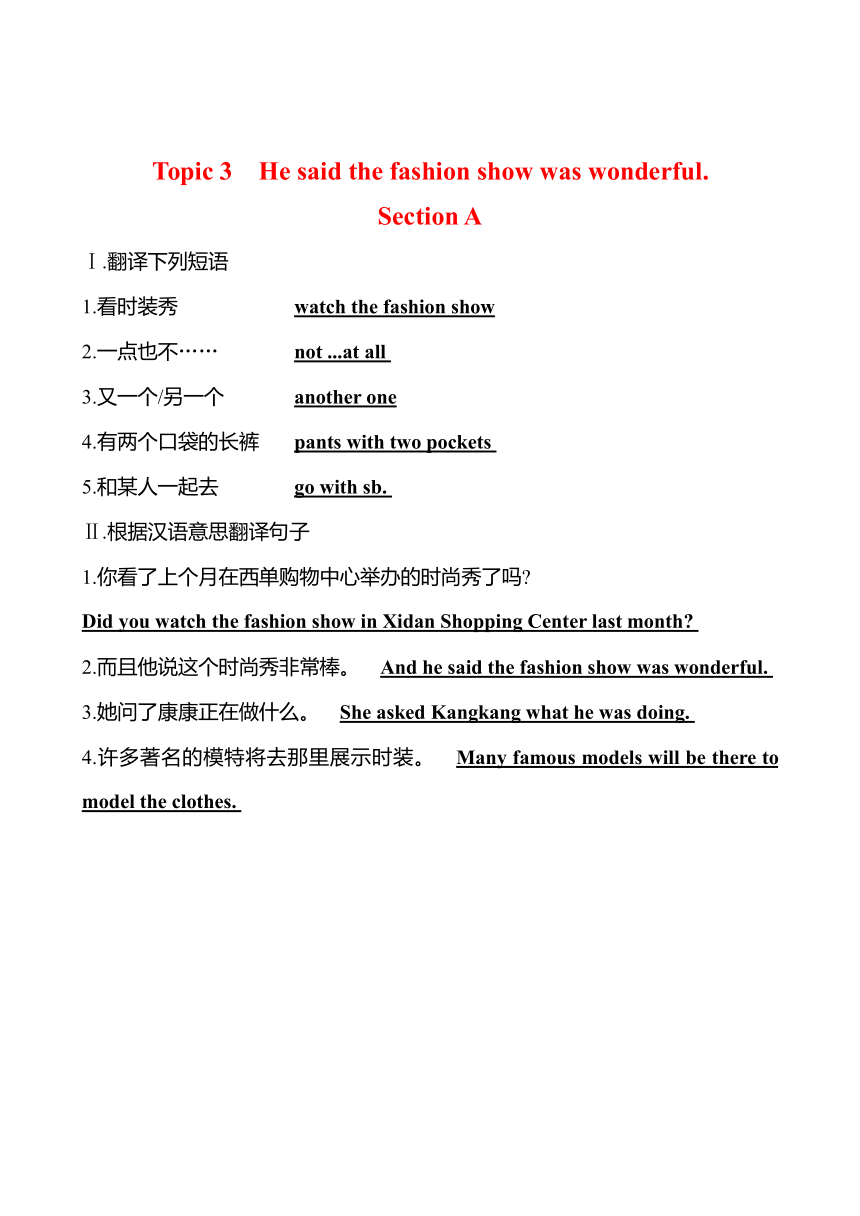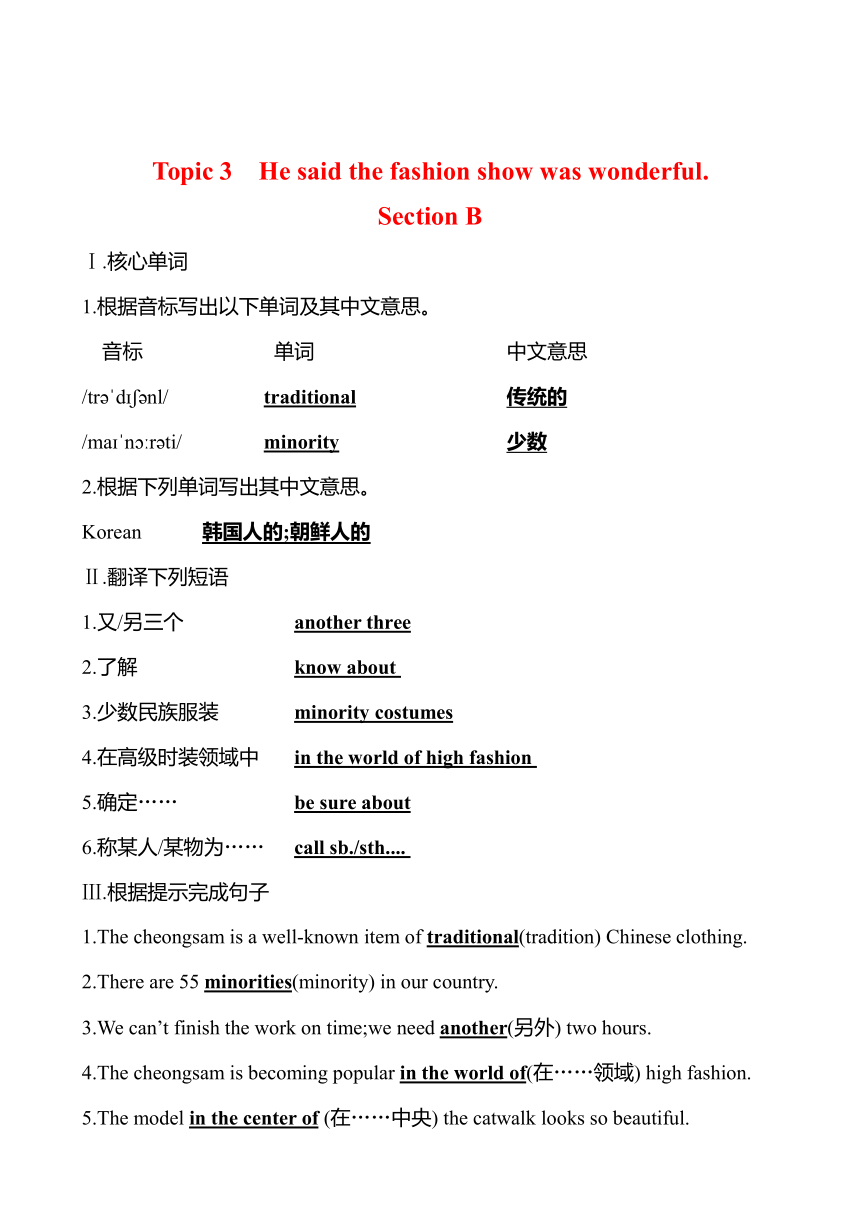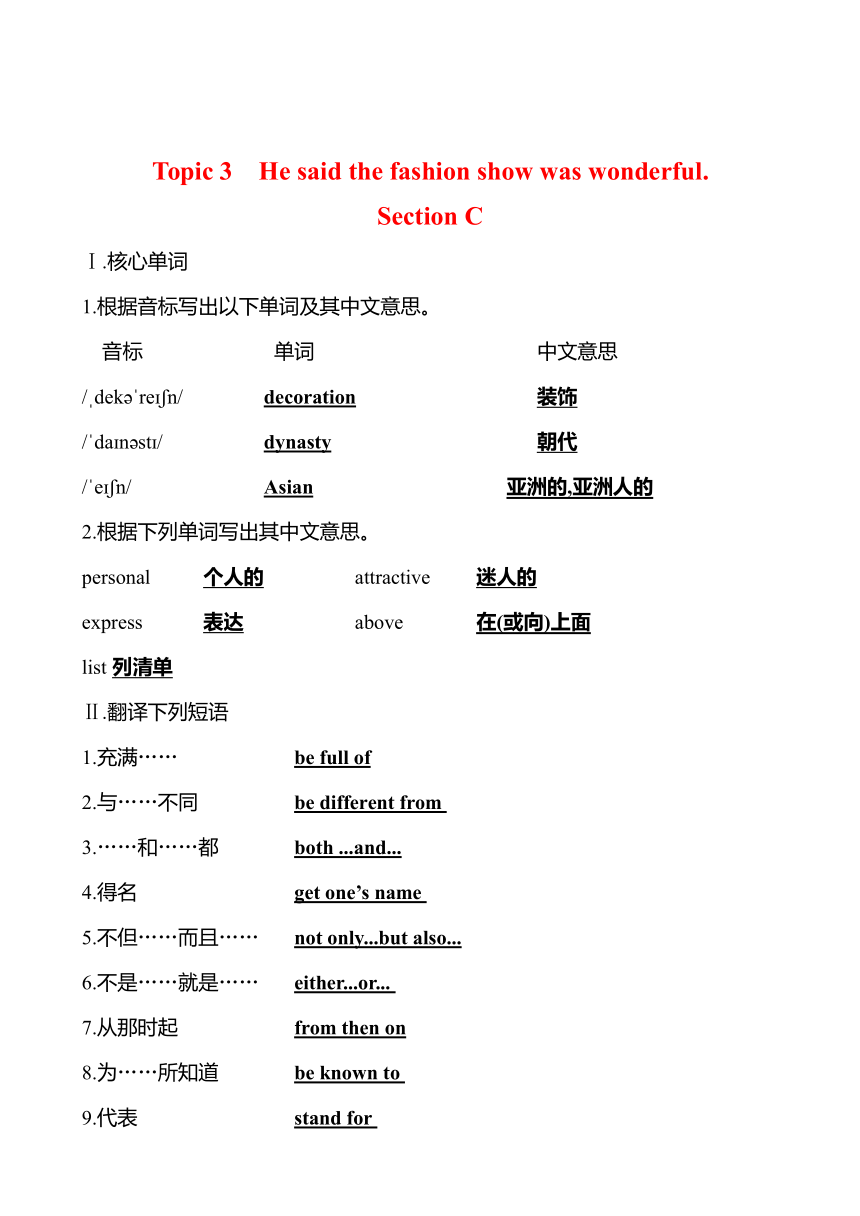Unit 8 Our Clothes Topic 3 知识清单 初中英语仁爱版八年级下册
文档属性
| 名称 | Unit 8 Our Clothes Topic 3 知识清单 初中英语仁爱版八年级下册 |

|
|
| 格式 | docx | ||
| 文件大小 | 23.8KB | ||
| 资源类型 | 教案 | ||
| 版本资源 | 仁爱科普版 | ||
| 科目 | 英语 | ||
| 更新时间 | 2024-10-22 15:40:12 | ||
图片预览




文档简介
Topic 3 He said the fashion show was wonderful.
Section A
Ⅰ.翻译下列短语
1.看时装秀 watch the fashion show
2.一点也不…… not ...at all
3.又一个/另一个 another one
4.有两个口袋的长裤 pants with two pockets
5.和某人一起去 go with sb.
Ⅱ.根据汉语意思翻译句子
1.你看了上个月在西单购物中心举办的时尚秀了吗
Did you watch the fashion show in Xidan Shopping Center last month
2.而且他说这个时尚秀非常棒。 And he said the fashion show was wonderful.
3.她问了康康正在做什么。 She asked Kangkang what he was doing.
4.许多著名的模特将去那里展示时装。 Many famous models will be there to model the clothes.
Topic 3 He said the fashion show was wonderful.
Section B
Ⅰ.核心单词
1.根据音标写出以下单词及其中文意思。
音标 单词 中文意思
/tr d nl/ traditional 传统的
/ma n r ti/ minority 少数
2.根据下列单词写出其中文意思。
Korean 韩国人的;朝鲜人的
Ⅱ.翻译下列短语
1.又/另三个 another three
2.了解 know about
3.少数民族服装 minority costumes
4.在高级时装领域中 in the world of high fashion
5.确定…… be sure about
6.称某人/某物为…… call sb./sth....
Ⅲ.根据提示完成句子
1.The cheongsam is a well-known item of traditional(tradition) Chinese clothing.
2.There are 55 minorities(minority) in our country.
3.We can’t finish the work on time;we need another(另外) two hours.
4.The cheongsam is becoming popular in the world of(在……领域) high fashion.
5.The model in the center of (在……中央) the catwalk looks so beautiful.
Ⅳ.根据汉语意思翻译句子
1.乐意效劳。 With pleasure.
2.模特们登场了! Here come the models!
3.那不是一条简单的裙子, 人们称之为旗袍。That’s not a common dress.People call it a cheongsam.
4.又过来三个模特,而且她们三人都穿着少数民族的服装。
Here come another three models, and they are all in minority costumes.
5.但是对于最后一个,我不确定。 But I’m not sure about the last one.
Topic 3 He said the fashion show was wonderful.
Section C
Ⅰ.核心单词
1.根据音标写出以下单词及其中文意思。
音标 单词 中文意思
/ dek re n/ decoration 装饰
/ da n st / dynasty 朝代
/ e n/ Asian 亚洲的,亚洲人的
2.根据下列单词写出其中文意思。
personal 个人的 attractive 迷人的
express 表达 above 在(或向)上面
list 列清单
Ⅱ.翻译下列短语
1.充满…… be full of
2.与……不同 be different from
3.……和……都 both ...and...
4.得名 get one’s name
5.不但……而且…… not only...but also...
6.不是……就是…… either...or...
7.从那时起 from then on
8.为……所知道 be known to
9.代表 stand for
Ⅲ.根据句意或提示完成句子
1.—How many dynasties (dynasty) were there in ancient China
—Twenty-four, I think.
2.From then on, my brother got used to the life in the city.
3.I need your advice on a personal (person) matter, but it’s not about me.
4.The plane is flying above the clouds, so we can’t see anything around us in the sky.
5.Nancy is so shy that she is afraid of expressing (express) her opinion in front of others.
Ⅳ.根据汉语意思翻译句子
1.唐装代表了中国历史和时装文化。
The Tang costume stands for Chinese history and fashion culture.
2.唐装是在汉、唐时期中国开始闻名于世时得名的。
The Tang costume got its name when China became known to other countries during Han and Tang dynasties.
3.现在,人们既可以把唐装设计成正装,也可以设计成休闲装。它既展示了个人风格,又展示了中国的传统文化。
Today people can design the Tang costume as either formal or casual clothes.It shows both the personal style and China’s traditional culture.
4.因此,我们说唐装非常有吸引力并且与西服大不相同。
So we say the Tang costume is very attractive and very different from western-style suits.
Topic 3 He said the fashion show was wonderful.
Section D
Ⅰ.核心单词
1.根据音标写出以下单词及其中文意思。
音标 单词 中文意思
/ wel n n/ well-known 众所周知的
/ a t m/ item 一件物品
/t s/ choice 选择
2.根据下列单词写出其中文意思。
marriage 婚姻 celebration 庆祝
Ⅱ.翻译下列短语
1.在过去 in the past
2.几乎没人 few people
3.全世界 around/all over the world
4.由……做成 be made of
5.曾经;一度 at one time
6.在特殊的场合 on special occasions
7.在19世纪70年代 in the 1870s
Ⅲ.句型转换
1. Li Lei said,“I come from Shanghai.” (改为含有宾语从句的复合句)
Li Lei said that he came from Shanghai.
2.Do you know When does the train leave (改为含有宾语从句的复合句)
Do you know when the train leaves
3.One of the two boys must stay here.(改为同义句)
Either of the boys must stay here.
4.Both Lily and Lucy like dancing.(改为同义句)
Not only Lily but also Lucy likes dancing.
5.English names are not the same as Chinese names.(改为同义句)
English names are different from Chinese names.
Ⅳ.根据汉语意思翻译句子
1.它们对于全世界的年轻人来说都是最流行的服饰选择。
They are the most popular choice of clothing for young people around the world.
2.传统的和服是由丝绸制成的。
The traditional kimono was made of silk.
3.曾经,日本人在非正式场合和正式场合都穿和服。
At one time, Japanese people wore kimonos for casual and formal occasions.
Topic 3 He said the fashion show was wonderful.
话题小结
Ⅰ.词性转换
1. traditional(adj.传统的)→tradition(n.传统)
2.decoration(n.装饰)→decorate(v.装饰)
3.choice (n.选择)→choose(v.选择)
Ⅱ.写出下列名词的中文意思及形容词形式
名词 中文意思 形容词形式
tradition 传统 traditional
Asia 亚洲 Asian
person 人 personal
Ⅲ.句型转换
1.“Which model do you like best ” He asked.(改为复合句)
He asked me which model I liked best.
2.Can you give me two more hats (改为同义句)
Can you give me another two hats
3.She knows more about art than I.(改为同义句)
I don’t know as much as her about art.
4.Will it rain or not this evening I’m not sure.(改为复合句)
I’m not sure whether it will rain or not this evening.
5. Is there going to be a math exam on Saturday He wondered.(改为复合句)
He wondered if/whether there was going to be a math exam on Saturday.
Ⅳ.情景交际
1.你想说你正和你的朋友们在网上聊天,可以这么说:
I’m chatting online with my friends.
2.他说他会去车站接琼,可以这么说:
I’ll pick up Joan at the station.
3.你想告诉弟弟春节是中国的传统节日之一,可以这么说:
The Spring Festival is one of the traditional festivals in China.
4.你想说你妈妈喜欢传统京剧,可以这么说:
My mother likes traditional Peking Opera.
5.你想问对方为什么经常感冒,可以这么问:
Why do you often catch a cold/have a cold.
Section A
Ⅰ.翻译下列短语
1.看时装秀 watch the fashion show
2.一点也不…… not ...at all
3.又一个/另一个 another one
4.有两个口袋的长裤 pants with two pockets
5.和某人一起去 go with sb.
Ⅱ.根据汉语意思翻译句子
1.你看了上个月在西单购物中心举办的时尚秀了吗
Did you watch the fashion show in Xidan Shopping Center last month
2.而且他说这个时尚秀非常棒。 And he said the fashion show was wonderful.
3.她问了康康正在做什么。 She asked Kangkang what he was doing.
4.许多著名的模特将去那里展示时装。 Many famous models will be there to model the clothes.
Topic 3 He said the fashion show was wonderful.
Section B
Ⅰ.核心单词
1.根据音标写出以下单词及其中文意思。
音标 单词 中文意思
/tr d nl/ traditional 传统的
/ma n r ti/ minority 少数
2.根据下列单词写出其中文意思。
Korean 韩国人的;朝鲜人的
Ⅱ.翻译下列短语
1.又/另三个 another three
2.了解 know about
3.少数民族服装 minority costumes
4.在高级时装领域中 in the world of high fashion
5.确定…… be sure about
6.称某人/某物为…… call sb./sth....
Ⅲ.根据提示完成句子
1.The cheongsam is a well-known item of traditional(tradition) Chinese clothing.
2.There are 55 minorities(minority) in our country.
3.We can’t finish the work on time;we need another(另外) two hours.
4.The cheongsam is becoming popular in the world of(在……领域) high fashion.
5.The model in the center of (在……中央) the catwalk looks so beautiful.
Ⅳ.根据汉语意思翻译句子
1.乐意效劳。 With pleasure.
2.模特们登场了! Here come the models!
3.那不是一条简单的裙子, 人们称之为旗袍。That’s not a common dress.People call it a cheongsam.
4.又过来三个模特,而且她们三人都穿着少数民族的服装。
Here come another three models, and they are all in minority costumes.
5.但是对于最后一个,我不确定。 But I’m not sure about the last one.
Topic 3 He said the fashion show was wonderful.
Section C
Ⅰ.核心单词
1.根据音标写出以下单词及其中文意思。
音标 单词 中文意思
/ dek re n/ decoration 装饰
/ da n st / dynasty 朝代
/ e n/ Asian 亚洲的,亚洲人的
2.根据下列单词写出其中文意思。
personal 个人的 attractive 迷人的
express 表达 above 在(或向)上面
list 列清单
Ⅱ.翻译下列短语
1.充满…… be full of
2.与……不同 be different from
3.……和……都 both ...and...
4.得名 get one’s name
5.不但……而且…… not only...but also...
6.不是……就是…… either...or...
7.从那时起 from then on
8.为……所知道 be known to
9.代表 stand for
Ⅲ.根据句意或提示完成句子
1.—How many dynasties (dynasty) were there in ancient China
—Twenty-four, I think.
2.From then on, my brother got used to the life in the city.
3.I need your advice on a personal (person) matter, but it’s not about me.
4.The plane is flying above the clouds, so we can’t see anything around us in the sky.
5.Nancy is so shy that she is afraid of expressing (express) her opinion in front of others.
Ⅳ.根据汉语意思翻译句子
1.唐装代表了中国历史和时装文化。
The Tang costume stands for Chinese history and fashion culture.
2.唐装是在汉、唐时期中国开始闻名于世时得名的。
The Tang costume got its name when China became known to other countries during Han and Tang dynasties.
3.现在,人们既可以把唐装设计成正装,也可以设计成休闲装。它既展示了个人风格,又展示了中国的传统文化。
Today people can design the Tang costume as either formal or casual clothes.It shows both the personal style and China’s traditional culture.
4.因此,我们说唐装非常有吸引力并且与西服大不相同。
So we say the Tang costume is very attractive and very different from western-style suits.
Topic 3 He said the fashion show was wonderful.
Section D
Ⅰ.核心单词
1.根据音标写出以下单词及其中文意思。
音标 单词 中文意思
/ wel n n/ well-known 众所周知的
/ a t m/ item 一件物品
/t s/ choice 选择
2.根据下列单词写出其中文意思。
marriage 婚姻 celebration 庆祝
Ⅱ.翻译下列短语
1.在过去 in the past
2.几乎没人 few people
3.全世界 around/all over the world
4.由……做成 be made of
5.曾经;一度 at one time
6.在特殊的场合 on special occasions
7.在19世纪70年代 in the 1870s
Ⅲ.句型转换
1. Li Lei said,“I come from Shanghai.” (改为含有宾语从句的复合句)
Li Lei said that he came from Shanghai.
2.Do you know When does the train leave (改为含有宾语从句的复合句)
Do you know when the train leaves
3.One of the two boys must stay here.(改为同义句)
Either of the boys must stay here.
4.Both Lily and Lucy like dancing.(改为同义句)
Not only Lily but also Lucy likes dancing.
5.English names are not the same as Chinese names.(改为同义句)
English names are different from Chinese names.
Ⅳ.根据汉语意思翻译句子
1.它们对于全世界的年轻人来说都是最流行的服饰选择。
They are the most popular choice of clothing for young people around the world.
2.传统的和服是由丝绸制成的。
The traditional kimono was made of silk.
3.曾经,日本人在非正式场合和正式场合都穿和服。
At one time, Japanese people wore kimonos for casual and formal occasions.
Topic 3 He said the fashion show was wonderful.
话题小结
Ⅰ.词性转换
1. traditional(adj.传统的)→tradition(n.传统)
2.decoration(n.装饰)→decorate(v.装饰)
3.choice (n.选择)→choose(v.选择)
Ⅱ.写出下列名词的中文意思及形容词形式
名词 中文意思 形容词形式
tradition 传统 traditional
Asia 亚洲 Asian
person 人 personal
Ⅲ.句型转换
1.“Which model do you like best ” He asked.(改为复合句)
He asked me which model I liked best.
2.Can you give me two more hats (改为同义句)
Can you give me another two hats
3.She knows more about art than I.(改为同义句)
I don’t know as much as her about art.
4.Will it rain or not this evening I’m not sure.(改为复合句)
I’m not sure whether it will rain or not this evening.
5. Is there going to be a math exam on Saturday He wondered.(改为复合句)
He wondered if/whether there was going to be a math exam on Saturday.
Ⅳ.情景交际
1.你想说你正和你的朋友们在网上聊天,可以这么说:
I’m chatting online with my friends.
2.他说他会去车站接琼,可以这么说:
I’ll pick up Joan at the station.
3.你想告诉弟弟春节是中国的传统节日之一,可以这么说:
The Spring Festival is one of the traditional festivals in China.
4.你想说你妈妈喜欢传统京剧,可以这么说:
My mother likes traditional Peking Opera.
5.你想问对方为什么经常感冒,可以这么问:
Why do you often catch a cold/have a cold.
同课章节目录
- Unit 5 Feeling excited
- Topic 1 You look excited
- Topic 2 I’m feeling better now.
- Topic 3 Many things can affect our feelings.
- Unit 6 Enjoying Cycling
- Topic 1 We're going on a three-day visit to Mount
- Topic 2 How about exploring Tian’anmen Square?
- Topic 3 Bicycle riding is good exercise.
- Unit 7 Food festival
- Topic 1 We’re preparing for a food festival.
- Topic 2 I’m not sure whether I can cook it well.
- Topic 3 I Cooked the Most Successfully
- Unit 8 Our Clothes
- Topic 1 We will have a class fashion show.
- Topic 2 We can design our own uniforms.
- Topic 3 He said the fashion show was wonderful.
